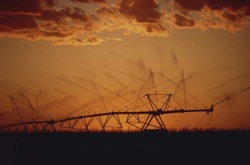Studies reveal huge water withdrawals from aquifers under California’s Central Valley
 The New York Times this weekend published a story and useful graphic describing new findings on the intensity of groundwater pumping in California’s San Joaquin Valley.
The New York Times this weekend published a story and useful graphic describing new findings on the intensity of groundwater pumping in California’s San Joaquin Valley.
One eye-opening note from Felicity Barringer’s article:
“…the total loss of groundwater from the Sacramento and San Joaquin River basins in California’s Central Valley from 2003 to 2010 was just under 16.5 million acre-feet — approximately the volume of the Lower Colorado River reservoir, Lake Mead, when it is full.”
Lake Mead is the nation’s largest man-made reservoir (and has not been full for some time).
The research, by scientists at a Massachusetts arm of the Stockholm Environment Institute, includes projections for water supply and demand in California and the Southwest. The article points out that about a third of Californians’ total water use is groundwater.
One thought on “The Central Valley’s Giant Sucking Sound”
Comments are closed.

We know it is happening, but when nothing looks different it is hard to convince people there is a problem. The USGS published a fact sheet on land subsidence in the US that dealt specifically with the impact of groundwater depletion. The USGS site that describes this project has a wonder photo taken in 1977 showing how much the lower the basin was then than in 1955 and 1925.
It makes me wonder what effect this will have on HSR if the trcksk start to change elevation.